Batchelors’ Row, Church Green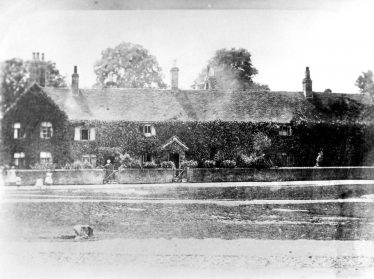
Miss Steabben had returned to Harpenden just after her childhood home, Ivy Cottage in Rothamsted Avenue and her father’s butcher’s shop on Church Green, had been pulled down, together with the cottages alongside, known as Batchelors’ Row, to make way for the shops, flats and garages which were due to be built on the site.
Miss Steabben was one of the three daughters of Mr and Mrs Walter Steabben who first came to Harpenden and took up residence at Ivy Cottage in 1875. Her sisters ran Walton House School in Tennyson Road. Miss Steabben moved away to Carshalton, Surrey, where she ran her own shop for many years. She recorded her memories of Victorian times, described in a walk round the environs of what was then truly a Hertfordshire village.
As she noted at the end of her article, “the writer does not claim authenticity for all these reminiscences as they are but childhood remembrances, but she hopes they may be of some interest as a picture of old times which she has endeavoured to portray.”
NB some editorial notes have been added between [..].
By the side of Ivy Cottage, before St Nicholas Estate was developed, across what is now Rothamsted Avenue, stood a white cottage facing Church Green and at right angles to the National School which, at that time, consisted of only one building.

1887 – Church Green
If one set out from Ivy Cottage just before nine o’clock in the morning when the children were arriving at school one heard the call, “All in! All in!” and the cry was taken up by those behind and those still further away. So, the patter of little boots rose to a crescendo until the church clock struck nine, when, as the Headmistress was a strict disciplinarian, most would be safely gathered in.

Girls playing on the Common outside the British School (seen through the trees) – now Park Hall, 1890s
The only other school, except for private establishments, was the old British School on the Common, now the Old Public Hall (Park Hall).

St George’s College in the time of Mr Wix
Later the Rev. S R H Wix founded “The College” as it was then called. [Mr Wix brought the St George’s school he had founded in Brampton to Harpenden in 1887, having built the new school in 1885. On his retirement in 1904 the first St George’s was closed and leased for a couple of years to a branch of the United Services College, before the present St George’s moved from Keswick in 1907 with Cecil Grant.] This was the beginning of St George’s School which, though now a co-educational school, was for boys only. They wore Eton suits with red caps, and, in the summer, straw hats with red bands.

Oriel House, 9 Milton Road
Oriel House School , a private school for girls and junior boys in Milton Road, gave a wonderful groundwork. The atmosphere was so happy and because the lessons were interesting as well it was just so easy to learn. And at “break” it was wonderful to tear out on to the lawn for “Tag” or baseball and all kinds of other games, some originated by the pupils.
A game of “Dabs”
On very hot days they would creep under the shelter of the low-lying trees to play “Dabs”, which was played with five marbles. It required much skill, especially the finale which was termed “Snacks”, where one had to throw five marbles into the air, pick up the one remaining on the ground and catch the other four overhand as they came down.
Then home at the end of the day, via Carlton Road to stand by the railway bank and spot the numbers of the engines with tall funnels.

Sketch of St Nicholas church from the east (Thompson’s Close?) artist unknown
Then on to the footbridge and down Thompson’s Close, flanked by lovely meadows (no houses then [in Bowers Way]), past Mr Jewer’s delightful shop where anything from a pair of boots or shoes to a piece of leather to mend them with could be purchased. Or it might be wool “in your favourite colour”, whatever that might be, or a host of other things.

Children playing on Church Green
Then across the Green where the National School children were also on their way home with skipping ropes, hoops of iron or wood that helped one along at a great rate, tops that were whipped along by their owners in most dexterous fashion and also helped the homeward trek, and various other aids to walking or running home. No buses in those days!
But all these games were strictly confined to their correct season of the year.
Cows and the Pond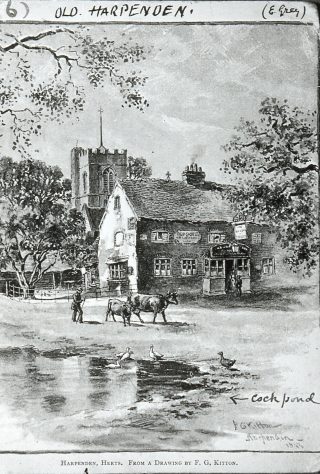
Cows by Cock Pond

Cows by Cock Pond
The cows would also be on their way home to be milked, and would stand and dream by the side of the old pond before wading in to cool their legs and quench their thirst.
And remember, this was on the high road. But there were no cars, lorries, motor scooters or motor-cycles, and a very few bicycles and “penny-farthings”. Everyone could then “stand and stare” without risk to life or limb.
As the reader will guess, the above includes some of the writer’s own personal reminiscences of her day at school.
Another memory is of Miss Austin’s sweet shop in the High Street, where one could linger, nose pressed against the window, wondering which make of sweet at two ounces for a penny would be most profitable. Some, you see, weighed much lighter than others.
When the decision was made and one was able to go inside there were large glass cases on the wall, full of dolls and other toys to entrance a small girl.
Gaffer Saunders’s Shop
Bowers House, watercolour by E Hasseldine

Bowers House, watercolour by E Hasseldine
At the back of the pond stood the delightful house with the big weeping willow in the front garden, owned by Dr Spackman and then by Dr Blake. Nestling beside its far gate was a little old thatched cottage shop with old Gaffer Saunders sitting in the far corner looking out of the shop window.
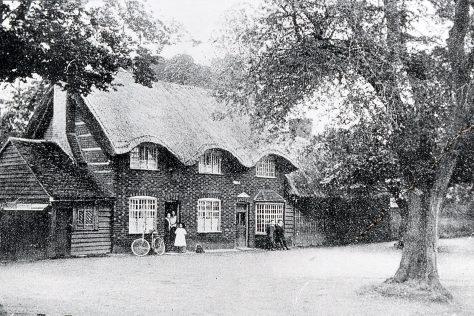
Thatched cottage near Bowers House
“What d’yer want?” he would ask in deep, gruff tones. But he sold wonderful cheese at 8d per pound and the shop was always as clean as a new pin.
Where Lloyds Bank now stands there was once another delightful shop that sold many, many things, and where customers were always treated as friends. If a child did not know what to buy, it was “Take it home and show your Mother, dear, and bring it back if it won’t do.”

Ridleys’ ironmongers c1910 – HSBC bank 2012
Then, sometimes for a change, the route up to Oriel House School would be by way of Station Road, past the livery stables owned by the Midland Hotel [Harpenden Arms], where the Post Office now stands. A smart ironmongers shop had just been opened on the corner, where now stands a Bank (HSBC]. But, as far as memory goes, there were no other shops.

Thatched cottages in Station Road, looking west
But at the junction of Station Road and what is now Victoria Road stood four dear little cottages on a bank, with long front gardens gay with flowers. Later, the Board School and the congregational Church were built [c1895], and before the latter was completed a short cut could be taken from Vaughan Road (also in the making) across the site of the church and through the cottage gardens.
And so up to the Midland Station, then so-called; or over the hill to the “Great Northern” branch railway station where, to return by the shorter cut to the Village one had to cross the line and scramble down the bank through a kissing-gate to a long field with a rough track running down its centre [Manland Common].

Sun Lane, before widening in 1929/30
Usually there was corn growing on parts of the field; sometimes lucerne or clover. Then through the next two fields to Carlton Road, following the short cut [Stewart Road], over the footbridge to the Village or by a short-distance detour down Sun Lane – much narrower than now with tall hedges on each side all the way down, and no houses until the one or two old cottages at the bottom. [One of] these now comprises the estate agents’ office, beautifully converted to keep the original character of the cottages.
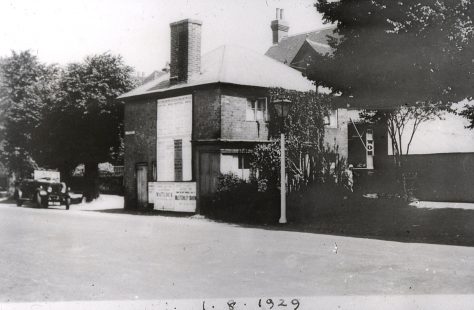
Turnpike cottage, 1920s
Then, turning in the direction of the Pond, we could go and call on the two little ladies who lived in the Turnpike Cottage that stood well out into the road and faced towards the Pond; in their sitting room were masses of hats, especially children’s, which presumably they made up themselves from the plait which was worked by hand by the cottage-dwellers from the rough plait dried on lines on Church Green and on the Common.
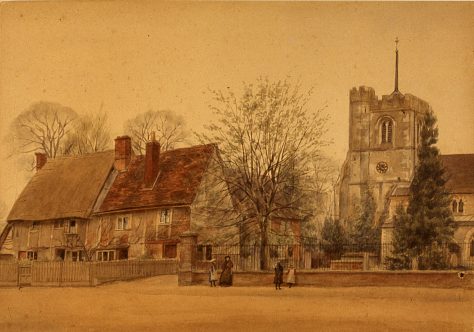
Cottages by the church
Probably the folk who lived in the picturesque cluster of cottages by the Church Gates did a lot of this work; so let us walk past these cottages to the Church Gates and stop to smell the lovely cream roses that climbed in such profusion over the cottage doors, then through the kissing-gate leading to Church Farm meadow adjoining.
What a profusion of buttercups there, and wild roses in the tall hedges; then to find the footpath that led on through the fields, and into Rothamsted Park to Redbourn.
But beware the big, black cattle grazing in the Park. And so one would arrive at the Lodge leading to Redbourn Lane, and if time would permit it would be a further lovely walk to carry on down the very steep hill past a beautiful larch spinney, under the railway bridge, where the little “Knickerbocker” train used to pursue its rather noisy way, as far as the watersplash.
Here a tiny clear stream tinkled along under a very narrow wooden footbridge and [continues] away through the valley meadows towards Friars Wash.
But there we must leave it for it would be a very long way to return over the hill past well-kept farms to Kinsbourne Green and thence left down the long winding Guess’s Lane (now Roundwood Estate) to the “Old Bell”.
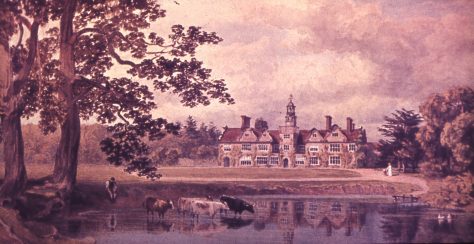
Reproduction of Rothamsted Manor, painted by Lady Lawes, c.1885
So, instead, leaving the Lodge on Redbourn Lane, let us turn left and walk back to Harpenden along this lovely lane, quite narrow then and shaded by tall, overhanging trees through which could be obtained glimpses of fields on one side, on the other, vistas of the Park with its cattle grazing and its more distant woods.

The White Horse, Hatching Green, c.1900
Presently there is a view of the House itself … in its setting of dark trees and terraced gardens. Then on to Hatching Green – so-called, I believe, because of its families of geese and ducks very many years ago. No modern houses here but just a few cottages, another Lodge and lastly, a little old country inn, still there but much enlarged [The White Horse].

Harpenden Common, with gorse and sheep
The road then leads us out to the Common, often bleak and windswept, but in the late spring aflame with its golden gorse and broom, the narrow intersecting grass paths bordered with dainty harebells and wild thyme making a sight that is not easily forgotten. What a joy it was to a child to walk along those fairy-like paths and to pick a nosegay from the wild flower borders. …
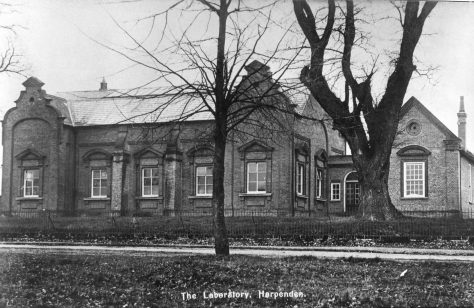
The Testimonial Laboratory, Rothamsted
Across the vista of the gorse stands out the first building of the Laboratory. Not the present large, light structure which stretches out far back into the Garden Fields at its rear, but a small, dark place, of which everyone was proud, especially when the Commemoration Stone was erected in front.
On our way down to the Village there stood, near the Laboratory, a white double-fronted cottage with a garden just one riot of colour, and there lived a little old lady of over eighty who had never worn glasses, but who could still do the finest needlework. Can you guess? It was the writer’s grandmother.
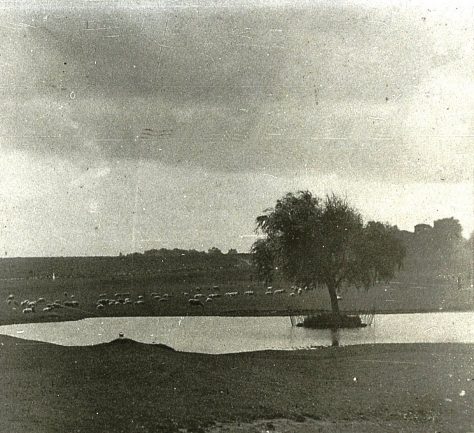
Silver Cup pond
Then on past the “Silver Cup” with the original pond in front with a willow tree in the centre.

Peacock House, on the site of the Methodist church
To the High Street again. There have been many changes here. About where the Methodist Church now stands there was a large house standing back from the road, with shuttered windows almost continental in appearance.
Miss Steabbens concluded with a description of Ivy Cottage – demolished 1959. We have not yet found any pictures of this house, though possibly this sketch gives a clue?*
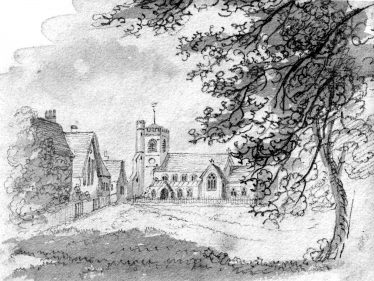
Sketch of Church Green – might the cottage on the left behind the bushes be Ivy Cottage?
The writer’s father and mother came to live in Ivy Cottage in 1875 when Harpenden was a tiny village. It has been difficult to find out anything much about its actual history but the following may give some idea of its earlier life.
Originally, it was probably a 13th or 14th [15-16th?] century cottage of “one up and one down” of which the exterior was the very old gable facing on to Rothamsted Avenue; the ground floor was of brick and the ceiling heavily and closely beamed.
The room above had a heavy oak floor and the walls were curiously formed of odd widths of wood …[with] large circular holes and long slots which were obviously not made for their existing purpose.
Above this room and reached only by a ladder was a loft which stretched only halfway across the room below. It had no covering except the huge roof gable. … There were indications in a deep recess by an old chimney that had been blocked up that there had been a door there to the more modern part.
Later additions
Later, a brick-floored kitchen was added adjoining the downstairs room I have already described which had a chimney-corner and a sunken ash-pit, and in a small place adjoining there was another chimney in which was one of those old baker’s ovens where the coals were raked out and the bread then put in to bake.
A staircase was also added which led to the upstairs room with the loft, and also to another room added above the kitchen. It was supported by two triangles of beams which carried the great stretch of tiled roof reaching almost to the ground.
When the front wing was added, much later, owing to these supporting beams the only means of access from the old to the new was found to be a low door – about four feet high.
The front part, probably early Georgian, was double-fronted with Gothic windows and was by far the largest part of the house, containing three sitting rooms and two halls with a concealed staircase leading to four bedrooms, the rooms all being small but cosy.
Licensed Farmhouse
Before the last wing was added the place was probably a farmhouse, and these being at one time licensed, the old kitchen became the bar-parlour for the farm labourers in the evenings. A chimney-corner was also found in the back sitting-room of the Georgian part of the house.
There was an old pump-well near the house which also served surrounding cottages; it is probable that the old barns at the back of the Tudor houses also just demolished, were at one time cottages of one room up and one down, and all these were served by the well as there was a connecting door from one of the gardens to the well-house.
There was also a right-of-way from Church Green up to the well, so probably there were at one time other cottages that were allowed to use it.
* We are delighted that Roger Morris has responded to this plea, with his collection of references and photos from Adrian Steabben Hepworth’s family albums.
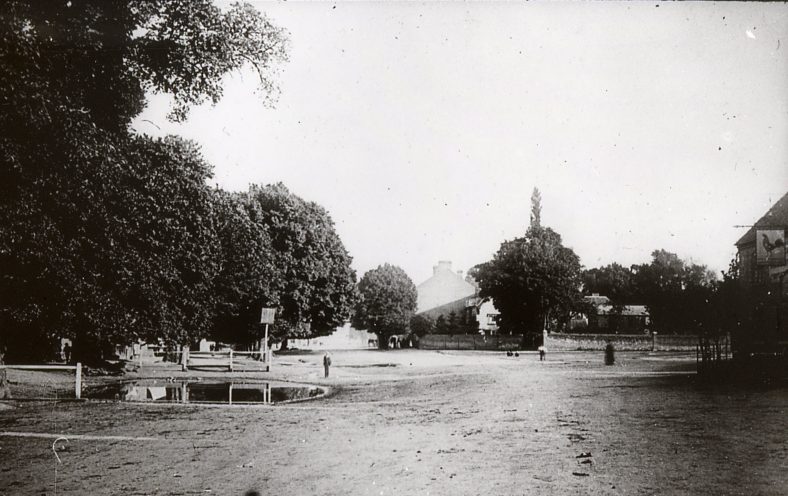
Harpenden High Street, looking south, c.1890

No Comments
Add a comment about this page